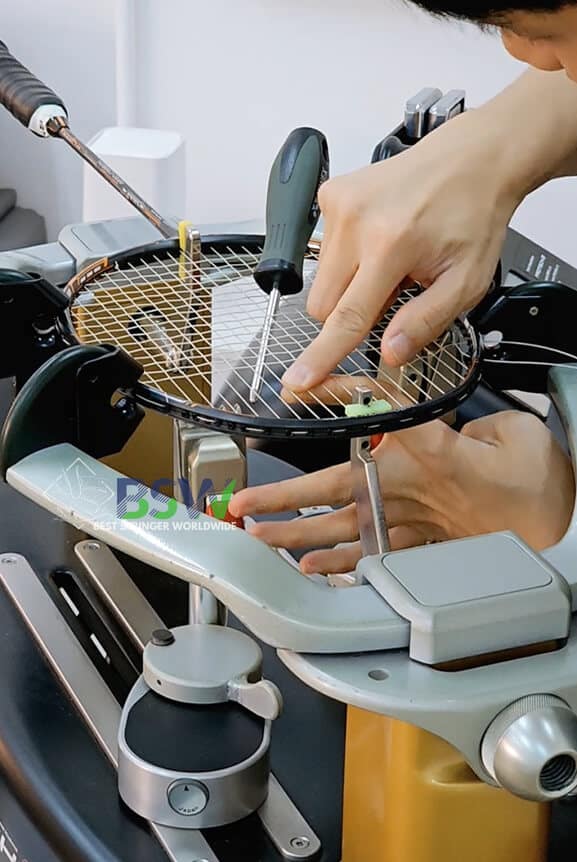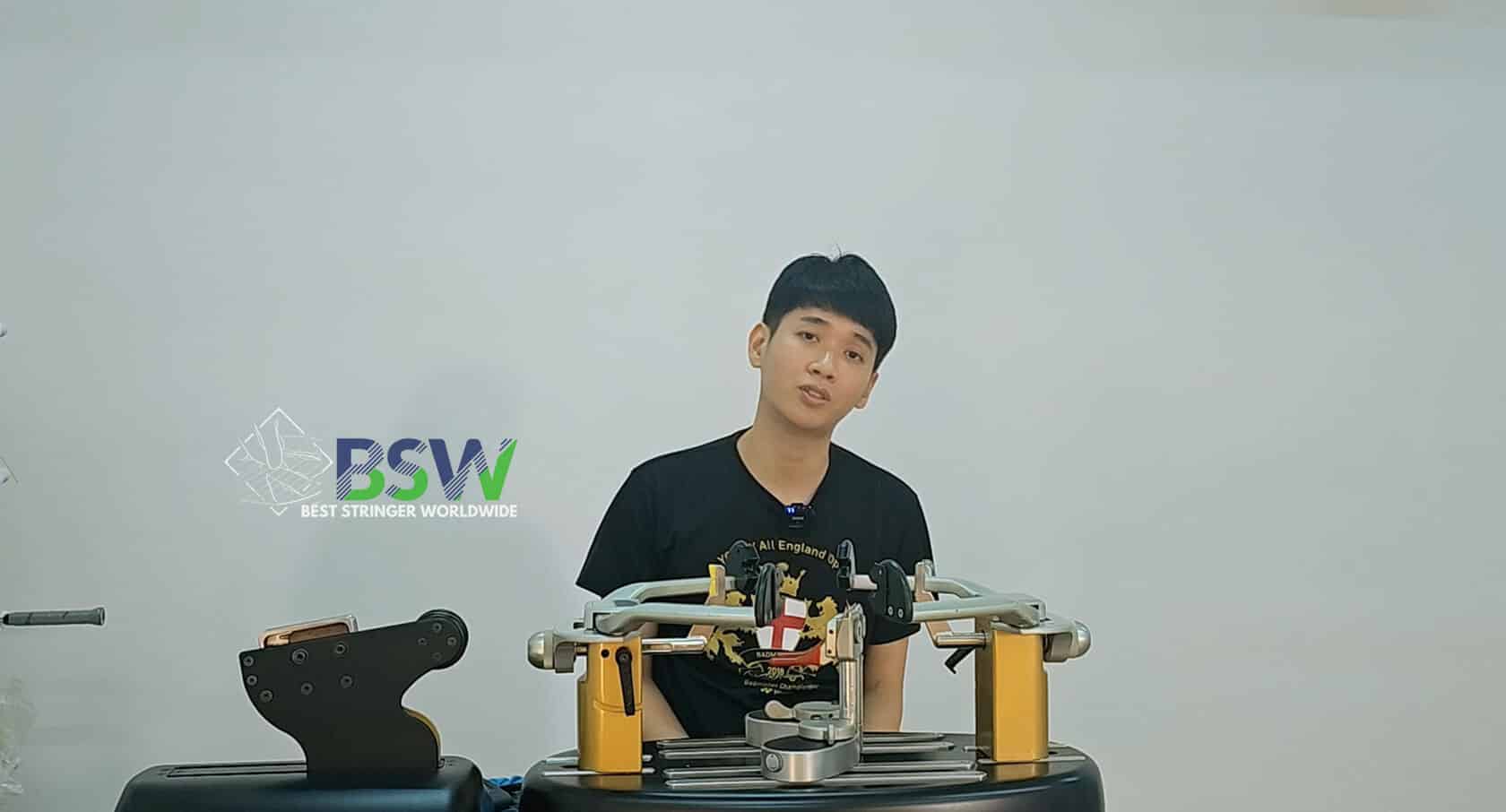Interactive Racquet Frame Simulator
Understanding Badminton Racquet Frame Shapes and Materials: A Comprehensive Guide
Welcome to Best Stringer Worldwide’s (BSW) in-depth exploration of badminton racquet frame shapes and materials. As leaders in badminton stringing education, we’ve created this guide to help players and aspiring stringers understand how racquet design impacts performance. Whether you’re considering our badminton stringing course or simply want to improve your game, this knowledge is crucial for making informed decisions about your equipment.
The Evolution of Racquet Frame Shapes
Over the years, badminton racquet design has evolved significantly, with manufacturers constantly seeking ways to improve aerodynamics, power, and control. Let’s explore the main types of frame shapes and their characteristics:
1. Box-Shaped Frames: The Classic Powerhouse
Box-shaped frames were among the earliest designs in badminton racquets. These frames are characterized by their robust and sturdy structure, offering several advantages:
- High frame rigidity
- Excellent torsional support
- Superior control
- Great power transfer
However, the trade-off for these benefits is higher air resistance during swings, which can slightly reduce swing speed.

2. Wing-Shaped Frames: Embracing Aerodynamics
As badminton technology advanced, manufacturers introduced wing-shaped frames to address the air resistance issue of box-shaped designs. Wing-shaped frames offer:
- Reduced air resistance
- Faster swing speeds
- Ability to generate powerful, aggressive returns
The downside is that these frames may provide slightly less control compared to box-shaped frames due to their thinner cross-section.
3. Hybrid Designs: The Best of Both Worlds
Recognizing the strengths of both box and wing shapes, racquet manufacturers began developing hybrid designs. These include:
- Trapezoidal cross-sections
- Hexagonal cross-sections
- Diamond cross-sections
These hybrid shapes aim to balance structural strength with aerodynamic efficiency, offering a middle ground between control and speed.
The Three-in-One Frame: A Case Study in Innovation
Some manufacturers have taken the hybrid concept even further. For example, one design incorporates three different frame shapes in a single racquet:
- Box shape at the T-joint: Enhances frame rigidity and provides high torsional support.
- Wing shape at 3 and 9 o’clock positions: Reduces air resistance and increases swing speed.
- Trapezoidal shape at the top of the frame: Offers aerodynamic benefits while maintaining structural integrity.
This innovative approach demonstrates how manufacturers are continually seeking to optimize racquet performance by combining the benefits of different frame shapes.
Understanding String Bed Density
Another crucial aspect of racquet design is the string bed density. The number and spacing of string holes can significantly impact a racquet’s performance:
- Lower density (fewer holes): Provides more power at the same string tension
- Higher density (more holes): Offers more control and allows for lower tension while maintaining power
Some brands have developed high-density string beds, increasing the number of holes from the standard 72 to 88. However, it’s important to note that extremely high density can potentially compromise frame strength.
Quick Quiz: Test Your Knowledge
Which type of string bed density typically provides more power at the same string tension?
The Evolution of Racquet Materials
The materials used in racquet construction have a profound impact on performance. Let’s explore the evolution of racquet materials:
- Pre-1970s: Wood and steel dominated
- 1970s: Introduction of aluminum alloys
- Modern era: Carbon fiber (graphite) becomes the primary material
Today’s market offers racquets in various material compositions:
- Full carbon fiber (highest quality)
- Carbon-aluminum composites
- Full aluminum (entry-level)
High-end racquets often incorporate additional materials to enhance performance:
- Basalt fiber
- Titanium alloys
- High-modulus carbon fiber
These materials offer benefits such as reduced weight, increased strength, improved durability, and enhanced vibration absorption. They also allow manufacturers greater flexibility in designing racquet characteristics like stiffness, feel, and overall performance.
| Material | Hardness | Strength | Vibration Absorption |
|---|---|---|---|
| High-modulus Carbon Fiber | 8 | 7 | 4 |
| Standard Carbon Fiber | 5 | 8 | 4 |
| Aluminum Alloy | 2 | 4 | 1 |
| Wood | 1 | 1 | 10 |
Choosing the Right Racquet: Tips from BSW
When selecting a badminton racquet, consider the following tips from our expert stringers at Best Stringer Worldwide:
- Check the material composition: Look for labels indicating the racquet’s materials, such as “High Modulus Graphite” or “All Graphite.”
- Be wary of counterfeit products: Authentic racquets will have accurate material labeling.
- Differentiate between full carbon and carbon-aluminum hybrids:
- Touch test: Aluminum frames feel cool, while carbon feels warm
- String groove shape: Aluminum has shallow, curved grooves; carbon has trapezoidal grooves
- Weight distribution: Aluminum frames have heavier heads
- Consider your physical attributes: Height, arm length, and strength can influence your racquet choice. For example, taller players might benefit from “long” racquets, while those with less arm strength might prefer “light” models.
- Think about your skill level: Beginners might prefer racquets with larger sweet spots (like MF designs), while advanced players might opt for more specialized features.
- Test different racquets: If possible, try out racquets with various features to see which feels most comfortable and enhances your performance.
Remember, the best racquet for you is one that complements your playing style and physical attributes while helping you improve your game.
The Importance of Proper Stringing
While understanding racquet terminology is crucial, it’s equally important to recognize the role of proper stringing. At BSW, our badminton stringing course emphasizes how the right string and tension can significantly impact a racquet’s performance, regardless of its built-in features.
- String type can affect power, control, and durability
- String tension influences the racquet’s sweet spot and overall feel
- Proper stringing technique ensures consistent performance across the entire string bed
Our racquet stringing certification program teaches stringers how to optimize these factors for each unique racquet and player combination.
Conclusion: Empowering Your Badminton Journey
Understanding badminton racquet terminology is more than just learning a new vocabulary – it’s about empowering yourself to make informed decisions that can elevate your game. Whether you’re a player looking to upgrade your equipment or an aspiring stringer aiming to provide top-notch service, this knowledge forms the foundation of your badminton journey.
At Best Stringer Worldwide, we’re committed to advancing the art and science of badminton equipment. Our comprehensive badminton stringing courses and certification programs delve even deeper into these concepts, providing hands-on experience and expert insights.
Remember, the world of badminton technology is constantly evolving. Stay curious, keep learning, and don’t hesitate to reach out to BSW for the latest updates and expert advice. Your perfect racquet – and your best game – awaits!
Racquet Feature Recommender
Your Playing Style: Offensive Defensive All-Round Your Experience Level: Beginner Intermediate Advanced Get Recommendation
We hope this comprehensive guide has enhanced your understanding of badminton racquet terminology. Remember, at BSW, we’re always here to support your badminton journey, whether through our expert stringing services, educational resources, or professional badminton stringing certification programs. Keep exploring, keep learning, and elevate your game with BSW!

About Best Stringer Worldwide
Best Stringer Worldwide is a comprehensive badminton and tennis stringing education program. We provide in-depth training on stringing techniques, racquet technology, and player-specific customization. Our curriculum is designed to help stringers understand and meet the needs of all badminton players, from casual enthusiasts to competitive athletes.
Read More